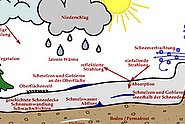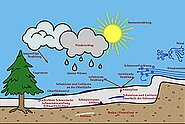Would you like to know how the snowpack changes in the course of the winter? Are you interested in mass and energy exchange between the atmosphere, the snow and the soil? Then it's worth taking a look at SNOWPACK.
The SNOWPACK model applies meteorological input data to describe the layering of the snowpack and the snow microstructure. Developed primarily for avalanche warning purposes, it is now used all over the world to create models for snowpack changes.

SNOWPACK is based on a Lagrangian finite element implementation and solves the non-stationary heat transfer and settlement equations (Fig. 1). It encompasses phase transitions and the transport of liquid water. In particular, the model focuses on the mechanical and physical properties of snow, including thermal conductivity and viscosity, snow metamorphism, and interaction with the atmospheric boundary layer. It also examines how shortwave radiation penetrates the snowpack. SNOWPACK thus facilitates a detailed analysis of the flows of energy and mass between the atmospheric boundary layer and the cryosphere. As regards microstructural detail, SNOWPACK now ranks among the most advanced snowpack models. Current development work on SNOWPACK is concentrating on the assessment of snowpack stability, the refined transport of liquid water through the snowpack, and vapour exchange by the snowpack.
Structure of physical modelling
SNOWPACK is based on the modelling of a one-dimensional soil/snow/vegetation column (Fig. 2). It focuses on vertical gradients and transfers at the expense of lateral transfers. It models snow as a porous three-phase (ice / liquid water/ water vapour) medium. To enhance the simulation of the soil/snowpack interface, soil layers (including ice formation,
water content etc.) can also be added to the model. Soil and rock layers can be modelled down to a variable depth, which is a useful option particularly when simulating permafrost. Any number of layers can be simulated, including weak layers and transitional boundaries, such as those formed by surface or depth hoar (cup-shaped crystals). Thanks to its Lagrangian grid, SNOWPACK can also simulate very thin layers, including ice lenses.
Typical operational application
SNOWPACK is in operational service within a network of around 160 automatic weather and snow measuring stations distributed throughout Switzerland. These stations measure the wind, air temperature, relative humidity, snow depth, surface and soil temperature, reflected shortwave radiation and, in a few cases, three temperatures within the snowpack. The measured values, which drive the model, are transmitted to the SLF hourly. SNOWPACK thus generates additional information concerning the state of the snowpack at the places where the automatic measuring stations are situated. The model is connected to a relational database, which stores both the measured values and the results produced by the model. Validations of SNOWPACK have shown that the calculations concerning the mass balance and energy budget are reliable. The modelling of snow metamorphism yields appropriate grain types and is capable of simulating key processes, such as the formation of depth hoar and surface hoar. SNOWPACK is also in operational service in other countries.
Other applications
Apart from operating as a standalone programme, SNOWPACK is often combined with other models as well. If it is coupled to models of the atmospheric boundary layer, for example, a terrain model can be implemented to estimate snow transport, or the spatial energy balance can be calculated. Such coupled models are used to examine the depositing of snow and changes in the snowpack in steep terrain, or to forecast the condition of ski runs to be used for racing.
Current use
More than 200 scientists working in over 35 institutions are using SNOWPACK for research purposes. It has been applied successfully to the Alps, Scandinavia, North America, Japan, Russia, China, India, Chile and the polar regions (Greenland and Antarctica). Together with its three-dimensional variant Alpine3D, SNOWPACK is being used in diverse fields, including for studies relating to the influence of climate change and snow stability issues, for hydrological studies, as well as in road network weather applications, permafrost research and in connection with snowfarming.




